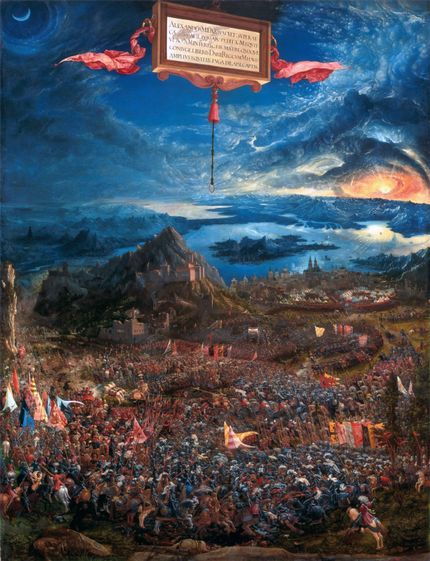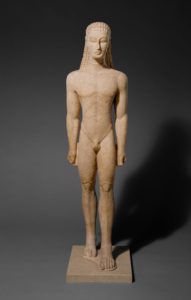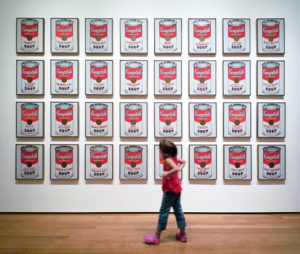 Loading...
Loading...
Final Project
 Loading...
Loading...
 Loading...
Loading...
Topic: Humanism throughout history. Thesis Statement: Although the humanism movement started during the time of ancient Greece and Rome it is still seen portrayed in artwork today. Introduction: Humanism is the a movement in art history that shifted the focus of art works from deities and worshiping the deities to a focus on humans, more specifically the ideal human. Instead of valuing a God or religion during the movement people began to focus more on valuing humanity therefore making themselves gods. equal to gods by putting themselves at the center of all social and moral concerns. Prior to the humanism movement art was typically made to worship the deities. An example of this can be seen in the photograph of the Standing Male Worshiper. Prior to the humanism movement art was typically made to worship the deities. The Standing Male Worshiper is an example of a piece of artwork that was created before the humanism movement. As it can be seen in the photograph the creator of this sculpture did not put much effort into adding detail to the human represented in the sculpture. The artist of the sculpture created it to serve one purpose which was to be a praying stand in for the person it represented.Artist: N/A Title: Standing Male Worshiper Date: 2900–2600 B.C. Museum: The Metropolitan Museum of Art As time began to progress so the idea of humanism began to form and the shift from making art that focused on deities and worshiping them to making art that worshiped humanity and focused on the ideal human body. An example of an artwork that showed the start of the transition from focus on deities to a focus on humans is the Statue of Kouros. Unlike the Standing Male Worshiper which had almost no detail on the human body, the Statue of Kouros focuses soley on the human body. It is a representation of a young nude male. The artist of this sculpture adds small but noticeable details such as the outlining of the mans abs and chest. Another faint but drastic difference between the two sculptures is the sense of movement that can be seen in the legs of the Statue of Kouros. As seen in the photograph below, the left leg of the statue strides forward giving the sculpture a feeling of movement.
. Artist: N/A Title: Statue of Kouros Date: 600 BCE Museum: The Metropolitan Museum of Art As more time passed the humanism movement became larger and lead to much more drastic changes in the art world. An example of a artwork that shows drastic a drastic change due to the humanism movement is the statue of Polykleitos. Similar to the statue of Kouros, the Doryphoros has a sense of movement but different to the Kouros, the Doryphoros has no symmetry. Instead the statue of Polykleitos has contrapposto. Contrapposto is the use of counter balancing to form "an asymmetrical arrangement of the human figure in which the line of the arms and shoulders contrasts with while balancing those of the hips and leg."(Google definition).By giving the statue contrapposto it the artist was able to show that the statue is suppose to represent a person walking.
Artist: Polykleitos Title: Doryphoros (Roman copy) Date: 450-440 BCE Museum: Museo Archaeologico Nazionale (Naples) Proposal/Task: The student is to select five modern pieces of artworks and explain how they represent/show that the humanism movement is still a part of art to this day. Requirements: Assemble a minimum of five works of art that relate to the thesis statement. Images should have the following information: artist, title, date. Conclusion: After gathering and explaining the 5 artworks you have chosen the reader/ grader of this assignment should be able to easily tell how each individual piece of art relates to the humanism movement and how it is similar or different to the 3 artworks that I have listed above. Work Cited:Dr. Steven Zucker and Dr. Beth Harris, "Standing Male Worshipper (Tell Asmar)," in Smarthistory, December 16, 2015, accessed December 17, 2018, https://smarthistory.org/standing-male-worshipper-from-the-square-temple-at-eshnunna-tell-asmar/. “Standing Male Worshiper.” The Met's Heilbrunn Timeline of Art History, www.metmuseum.org/toah/works-of-art/40.156/. Dr. Beth Harris and Dr. Steven Zucker, "Marble statue of a kouros (New York Kouros)," in Smarthistory, December 20, 2015, accessed December 17, 2018, https://smarthistory.org/marble-statue-of-a-kouros-new-york-kouros/. “Marble Statue of a Kouros (Youth).” The Met's Heilbrunn Timeline of Art History, www.metmuseum.org/toah/works-of-art/32.11.1/. Dr. Beth Harris and Dr. Steven Zucker, "Polykleitos, Doryphoros (Spear-Bearer)," in Smarthistory, August 8, 2015, accessed December 17, 2018, https://smarthistory.org/polykleitos-doryphoros-spear-bearer/. “Marble Statue of a Kouros (Youth).” The Met's Heilbrunn Timeline of Art History, www.metmuseum.org/toah/works-of-art/32.11.1/.
 Loading...
Loading...
This is my take on the creative segment of the final project. Here’s the Link of it on google drive(attached is my drawing): https://drive.google.com/open?id=1eT-6Rc_6BfFeFD3Bnu2obyU4HDykjcg_nfqtaof7bEo
“Baroque Art, an Introduction.” Smart History, 17 Dec. 2018, www.smarthistory.org/a-beginners-guide to-baroque-art/
This article gives an overall history course on the Baroque period. Using this information will give the necessary background to set the paper proposal.
“Baroque period.” New World Encyclopedia, 17 Dec. 2018, www.newworldencyclopedia.org/entry/Baroque_period
The facts in this article are also about the history of the Baroque period but are more detailed which will elaborate on this background information in my paper proposal.
“Baroque vs. Rococo: Similarities and Differences, Explained.” In Good Taste, 17 Dec. 2018, www.invaluable.com/blog/baroque-art-rococo-art/
The differences of the Baroque and Rococo periods are highlighted and explained. This article will give an understanding to the final stage of Baroque period.
Stechow, Wolfgang. “Definitions of the Baroque in the Visual Arts.” The American Society of Aesthetics, vol. 5, no. 2, 1946, www-jstor-org.ez- proxy.brooklyn.cuny.edu/stable/pdf/425798.pdf?refreqid=excelsior%3Ac0bc0e46251359f5497b 468886a954b3. Accessed 17 Dec. 2018.
Wolfgang digs deeper into the characteristics of the Baroque period. Particularly the proper way how defining the term baroque which also coincides with how baroque should be identified. When outlining the key components in the selected artworks, this article will be able to give a deeper analysis to the shared components.
Pijoan, Jose. “Romanesque Baroque.” The Art Bulletin, vol. 8, no. 4, 1926, www-jstor-org.ez- proxy.brooklyn.cuny.edu/stable/pdf/3046523.pdf?refreqid=excelsior%3Af3ef2c4683467544fbd 28940dc2cd82b. 17 Dec. 2018.
This article makes a point in claiming that different art period throughout history are often a reaction to its precedent art period and can show a blend of the itself and the precedent art period in the beginning and blend of itself and its subsequent art period. This main point can aid in following the time events of the Baroque period.
Throughout this course I have seen many beautiful paintings, sculptures, and architecture. Specifically, works of art that display leaders in power and Emperors after their victories in battle. Works of art that display their great wealth and power that they have conquered but not images of the battles themselves. I would like to see the art of the Emperors campaigns and the battles that took place.
“DEPICTIONS OF WAR”
Eugène Delacroix 1831
This painting’s main subject was discussed with several city Administrators and members of the Royal Society of Science. Until agreeing on the min focal point, death of Charles, The bold, Duke of Burgundy. Who was killed by the Knight of Lorraine, Claude de Bauzemont on January 5 1477. This was Delacroix first official commission and took him roughly 3 years to complete. “What is striking about this canvas is the exalted enthusiasm with which the artist detail the murderous tumult of the battle.” www.eugene-delacroix.com/
Delacroix used a warm and inviting red that had be complement well with the blue snowy background. Overall, the canvas brought together displaying the large scale of war in a small canvas.
Eugène Delacroix 1835
Eugène Delacroix 1830
Based on the story’s of Lord Byron about a slave, Lelia who was killed by her master, Hasen. And Giaour her lover on a mission for revenge.
Delacroix’s “Combat of Giaour and Pasha is a powerful constantly moving image clashing two soldier rising their horse at each other/ Delacroix plays with the shadow and light between the left and right side split the image down the middle and unveiling and underlying battle between light and dark.
Eugène Delacroix 1826
Commissioned by the Duchess of Berry, displaying a battle fought between Edward, Prince of Wales and John II of France. Delacroix captures the tipping point of this battle and the last moments of the kings freedom before he is taken prisoner. Using dark tones Delacroix painting vibrates of the grim view of war.
Eugène Delacroix 1831
For a Scene displaying so much violence Delacroix’s brush work and choice of wide range of red, blue, and yellows, create a vibrant yet powerful duel on horses.
Delacroix paints a dark image of the storming of the Convention and decapitation of the head of deputy Feraud. Delacroix dark images is matched with dark colors and bright red counter to really exaggerate the bloody scene.
The 18 greatest War and Battle painting, helped me compare the works of war from Delcroix to other artist from other periods. The one artwork that stood out the most for me would be Albercht Altdorfer, The Battle of he Alexander at Issus 1529. The paining has the most beautiful depiction of heaven or peace and calm emitted from the blue but on the other hand at the bottom chaos and a clash of waves of soldier and red blood is steered all the way to the horizon.

This article further helped me understand the different focuses the artist have when is comes to painting war. Peter Paul Rubens “Consequences of War” doesn’t display actual acts of war but rather , the God of war Mars marching thru the temple of Janus while Venus attempts to hold him back.

Bibliography
http://www.eugene-delacroix.com/
https://www.artic.edu/artists/40545/eugene-delacroix
https://www.metmuseum.org/
Article ( I only used 1 article, since it covered a wide period and 18 different articles about my theme)
https://explorethearchive.com/the-18-greatest-war-and-battle-paintings-of-all-time
When examining sculptures throughout various eras of art, it is now evident that many are nude. The nude is a significant part of art and it’s implications are just as significant, especially in Greco-Roma/Western art. However, it appears that more often than not, there are more male nude figures than the female figures, which poses the question of why this is. Further exploration of nude sculptures from the time periods prove that there are in fact many differences between the nude sculptures of men and women.
The emergence of the nude became more frequent in ancient Greek art. In the art from this decade, we see various different nude male sculptures with the ideal male body because the Greeks, unlike other ancient civilizations, did not associate the nude with indecency and weakness. These sculptures have athletic bodies and this was done as a way to signify everything the people of that time valued the most, such as, success, power, strength, and glory. The Greek youth already spent time in the nude when training or competing in athletic events so the nude was natural for them. In his book “Greek Art: From Prehistoric to Classical: a Resource for Educators” Michael B. Norris states that the Greek associated being in the nude to “heroic excellence.” For example, for my project one of the artworks I looked at was the 1st-2nd century Roman copy of the Marble statue of the Diandoumenos by Polykleitos from 430 B.C. that can be found at the MET. The statue depicts an athletic youth tying a fillet around his head; the MET’s description of the statue states that “the position of the feet- poised between standing and walking- gives a sense of potential movement,” which shows that the artists cared to show that the statues didn’t just have athletic figures but was actually moving and participating athletics. There are various copies of this statue and they imitate Polykleitos’ original portrayal of the male body because Polykleitos paid careful attention to his statues’ body parts, proportions, and stances. This is done not only to make the figures accurate but to help the audience get a proper sense of the heroic strength the statues are meant to exude. Norris also explains the importance of a well-proportioned body by stating that a “perfect proportioned, well-trained body was considered an outward manifestation of the striving for excellence that marked a hero.”
Most nude male statues do not shy away from illustrating the details of the male genitalia. However, when it comes to female nude statues it is the exact opposite. From all the different female statues that I examined, none of them were explicit with the detailing of the female genitals. This can be traced back to the fact that many viewed the female nude as a symbol of sex and sexuality and viewed that as shameful if it was not focused on fertility. For years, the female body was not shown in the nude unless it was the Goddess of Love, Aphrodite. This only started after the Aphrodite of Knidos by Prexiteles was created and became one of the very first sculptures of a nude female, setting precedent for other female nude sculptures. Nonetheless, breasts were not as taboo and are shown more commonly. The marble statue of a wounded Amazon (found at the MET), for example, shows an Amazonian woman with an injury under her right breast, while the other breast is covered with her clothes. Another example is the Marble statue of a Seated Muse, which shows a muse sitting on a rock. While her breasts her exposed, the lower half of her body is covered with clothing.
For my project I chose to create a collage of various sculptures in the nude. In my collage, you can see the differences in the depictions of male genitalia versus the female; one is almost always more detailed than the other. The male’s perfect athletic bodies are also shown and the females’ breasts are visible in all the artworks shown. The differences between the bodies of men and women in sculptures is evident when look at art. The power of art is that we can get a message across just by showing, so rather than using words to compare the difference between Michelangelo’s “David” and a statue of Aphrodite, I chose to juxtapose the numerous female and male statues in a collage as a good way to look into this.

Rachel Swed
Art 1010
Professor Shaw
Art has been the center of many great civilizations. We see this all the way from the Egyptian art till today. Art has changed greatly over time but its ability to portray emotion or tell a story has remained. Art has become the center of human creativity and has existed for thousands of years. But what impacted artist from civilization to civilization and how did art evolve into what it is today?

In ancient Egypt, art was used to teach or portray a story, mainly for religious teachings and common rituals. Examples of this can be the numerous painting, sculptures, and pieces of gods, pharaohs, and death masks. One example from the Brooklyn Museum is The Head of a Queen, which is dated back to 1400 BCE. As we discussed in class, ancient civilizations loved making art pieces that depicted their rulers to demonstrate their power and reverence. This artwork was chosen because it’s a great example to show how prominent the kingdom was in Egypt. Religion has played a major key in the arts successes from music to paintings particularly in this civilization.

Contrarily, when looking at Greek and Roman art it incorporates humanism. Humanism’s main focus is on mankind, rather than divine or godlike matters. When looking at Greek and Roman art, we see large human sculptures like Kouros seen at the MET. This is a great example because the face, stomach, and legs of this sculpture are polished, glowing, and realistic, making it almost human. The sculpture also has robbed curls on its head, characteristic of Greek/Roman culture. The sculpture is standing on an angle, as if in motion making the figure seem alive. The nudity in this sculpture is a very common characteristic in Greek/Roman sculptures and painting which dates from the ancient time, continued during the whole timeline of art, was the presentation of their culture in everyday life. This shows how their cultures and confrontation with everyday life was shown in their artworks.

As we move out of ancient world arts and into a closer century, during the 19th century we see a slight shift to a different style of painting- landscape paintings which were very popular. Landscape paintings depicted the intense beauty of nature through the eyes of the artist. One famous artist Vincent van Gogh and his most prized work Starry Night seen at the MOMA is a great example of landscape art which is why I choose to use it. One major movement during this time was the Romantic movement which greatly popularized the interest of landscape art. Different art techniques were used and referred to as Impressionism and Post-Impressionism. Impressions strayed away from story-telling in their artworks and instead focused on drawing everyday life. Light and color were very important aspects in impressionist paintings.

In the 20th century, we still see movements affecting painting- one powerful one to begin with- the rights of colored people. This shows how art can be about what’s going on in society. The exhibit, soul of the nation has many artworks expressing the oppression faced by people of color. The artwork, Did The Bear Sit Under a Tree, by Benny Andrews, is a great example of the movement affecting blacks which is why I chose it. The painting caught my attention because of its honesty and rawness are seen by the aggressiveness of the lines and oil paint used. Furthermore, the rough texture symbolized the place he came from. From where he came, everything was rough – from the fabrics people used to the clothes they wore. That is why he chose to use a rough texture. The man in the painting looks like he is rolling away the American flag. His firmly straight face and fisted hand give him an angry appearance. The caption next to the picture states that this painting is a representation of a colored man during the civil rights movement “shaking his fist” at the flag which was supposed to protect him. In conclusion, I think that the painting successfully conveys the painter’s message. It clearly illustrates that the man is not happy with how the United States is treating colored people. This shows how art was used to portray what is affecting the people in the civilization.

Lastly, when moving into the 20th century we see what is prominent in this century- consumer culture and mass media. This was seen through the new art movement- pop art. Andy Warhol “Campbell’s Soup Cans” is a prime example of this because it shows the mass produced product and it was advertised everywhere- so much so that Warhol used to drink it every day for 20 years! This thirty-two canvas painting represents the thirty-two soup flavors which were displayed on shelves together to look like grocery aisles at first. The bases of this kind of modern art is taking something which is not initially seen as art and makes us think about it in a different way. This art shows what was important then and now-mass production- and how it affected artworks of the 20th century.
Art has transformed over time to become even more complex, and its interpretations have changed as well. Today, good artworks give a different meaning to each individual person. Art can tell a story, depict a beautiful scene of nature, or convey humor. Art does not have to be specific or follow certain guidelines compared to art in the middle ages. If it weren’t to the inspiring individuals who shaped the development of art today, the diversity of artworks we have today wouldn’t exist. From movies to marketing and advertising, modern art is becoming more involved digitally while maintaining the physical beauty of what art is. Art shapes identities and impacts our society as a whole. Art helps creativity thrive and with the constant negativity in our continuing fast developing society, we need to embrace and support art now more than ever. Overall, we see how art changed from civilization to civilization based on what was prominent or important at that time. From ancient Egyptian which religion primed them to make their pieces to modern art where movements and mass media was a huge part of civilizations and impacted what was seen in the art at that time.
Work Cited Page:
Dr. Beth Harris and Dr. Steven Zucker, “Marble statue of a kouros (New York Kouros),” in Smarthistory, December 20, 2015, accessed December 9, 2018, https://smarthistory.org/marble-statue-of-a-kouros-new-york-kouros/.
Dr. Noelle Paulson “Vincent Van Gogh, The Starry Night.” Smarthistory, accessed December 14, 2018, smarthistory.org/van-gogh-the-starry-night/.
Gisela M. A. Richter. “The Greek Kouros in the Metropolitan Museum of Art.” The Journal of Hellenic Studies, vol. 53, 1933, pp. 51–53. JSTOR, JSTOR, www.jstor.org/stable/627245.
“MoMA Learning.” Lee Bontecou. Campbell’s Soup Cans. 1959 | MoMA, www.moma.org/learn/moma_learning/andy-warhol-campbells-soup-cans-1962/.
“The Fascinating Story behind Andy Warhol’s Soup Cans | Art | Agenda.” Phaidon, www.phaidon.com/agenda/art/articles/2013/february/22/the-fascinating-story-behind-andy-warhols-soup-cans
Bibliography: Museum Sites
This is useful because it provides two videos that go into detail about the statue Kouros and how it was made based on Greek and Roman Culture. It goes into each feature of the sculpture and what it represents. This is helpful for my project because it offers descriptions on the kouros and what the body represents. This is related to my project of how art evolved when I talk about art in the ancient Greek world.
2. Dr. Noelle Paulson “Vincent Van Gogh, The Starry Night.” Smarthistory, accessed December 14, 2018, smarthistory.org/van-gogh-the-starry-night/.
This link is useful because it talks about the details of this famous painting by Van Gogh including: the landscape, challenges, and the location. It even goes more in-depth with the colors of the sky. Overall, it does a great formal analysis of the painting extremely useful for my final project.
This talk about the time period in which the painting was made and details about the painting that are not made known which I find useful to my project to connect it to other time periods.
Bibliography: Magazines/articles/journals:
This article published by Phaidon is useful because it gave me insight about why Warhol painting the “Campbell’s Soup Cans.” It also talks about the paintings itself and how it was displayed and how he painted it. This is related to my project when I talk about modern-day art and how its way different than the art of the ancient world.
This journal article written by Gisela M. A. Richter is about the Kouros at The Metropolitan Museum. This article provides the significance of the statue of Kouros as well as information on the preservation of the Kouros and how it made its way into The Metropolitan Museum. This article is useful because it provides information on the Kouros and what the human body symbolizes in the statue. This is related to my project of how art evolved when I talk about art in the ancient Greek world.
